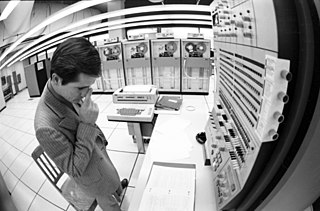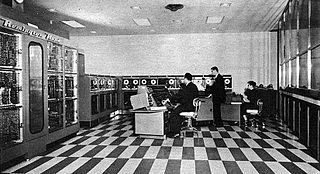
A mainframe computer, informally called a mainframe or big iron, is a computer used primarily by large organizations for critical applications like bulk data processing for tasks such as censuses, industry and consumer statistics, enterprise resource planning, and large-scale transaction processing. A mainframe computer is large but not as large as a supercomputer and has more processing power than some other classes of computers, such as minicomputers, servers, workstations, and personal computers. Most large-scale computer-system architectures were established in the 1960s, but they continue to evolve. Mainframe computers are often used as servers.

An operating system (OS) is system software that manages computer hardware, software resources, and provides common services for computer programs.

The IBM System/360 (S/360) is a family of mainframe computer systems that was announced by IBM on April 7, 1964, and delivered between 1965 and 1978. It was the first family of computers designed to cover both commercial and scientific applications and to cover a complete range of applications from small to large. The design distinguished between architecture and implementation, allowing IBM to release a suite of compatible designs at different prices. All but the only partially compatible Model 44 and the most expensive systems use microcode to implement the instruction set, which features 8-bit byte addressing and binary, decimal, and hexadecimal floating-point calculations.

In computing, time-sharing is the sharing of a computing resource among many users at the same time by means of multiprogramming and multi-tasking.

In computing, virtual memory, or virtual storage is a memory management technique that provides an "idealized abstraction of the storage resources that are actually available on a given machine" which "creates the illusion to users of a very large (main) memory".

Symmetric multiprocessing or shared-memory multiprocessing (SMP) involves a multiprocessor computer hardware and software architecture where two or more identical processors are connected to a single, shared main memory, have full access to all input and output devices, and are controlled by a single operating system instance that treats all processors equally, reserving none for special purposes. Most multiprocessor systems today use an SMP architecture. In the case of multi-core processors, the SMP architecture applies to the cores, treating them as separate processors.

Computer operating systems (OSes) provide a set of functions needed and used by most application programs on a computer, and the links needed to control and synchronize computer hardware. On the first computers, with no operating system, every program needed the full hardware specification to run correctly and perform standard tasks, and its own drivers for peripheral devices like printers and punched paper card readers. The growing complexity of hardware and application programs eventually made operating systems a necessity for everyday use.

UNIVAC was a line of electronic digital stored-program computers starting with the products of the Eckert–Mauchly Computer Corporation. Later the name was applied to a division of the Remington Rand company and successor organizations.

The Conversational Monitor System is a simple interactive single-user operating system. CMS was originally developed as part of IBM's CP/CMS operating system, which went into production use in 1967. CMS is part of IBM's VM family, which runs on IBM mainframe computers. VM was first announced in 1972, and is still in use today as z/VM.
General Comprehensive Operating System is a family of operating systems oriented toward the 36-bit GE/Honeywell mainframe computers.

CP/CMS is a discontinued time-sharing operating system of the late 1960s and early 1970s, known for its excellent performance and advanced features. It had three distinct versions:

Stratus Technologies, Inc. is a major producer of fault tolerant computer servers and software. The company was founded in 1980 as Stratus Computer, Inc. in Natick, Massachusetts, and adopted its present name in 1999. The current CEO and president is Dave Laurello. Stratus Technologies, Inc. is a privately held company, owned solely by Siris Capital Group. The parent company, Stratus Technologies Bermuda Holdings, Ltd., is incorporated in Bermuda.

z/VM is the current version in IBM's VM family of virtual machine operating systems. z/VM was first released in October 2000 and remains in active use and development as of 2020. It is directly based on technology and concepts dating back to the 1960s, with IBM's CP/CMS on the IBM System/360-67. z/VM runs on IBM's IBM Z family of computers. It can be used to support large numbers (thousands) of Linux virtual machines.
Digitek was an early system software company located in Los Angeles, California.
Transaction processing is a way of computing that divides work into individual, indivisible operations, called transactions. A transaction processing system (TPS) is a software system, or software/hardware combination, that supports transaction processing.

The IBM Time Sharing System TSS/360 is a discontinued early time-sharing operating system designed exclusively for a special model of the System/360 line of mainframes, the Model 67. Made available on a trial basis to a limited set of customers in 1967, it was never officially released as a supported product by IBM. TSS pioneered a number of novel features, some of which later appeared in more popular systems such as MVS. TSS was migrated to System/370 and 303x systems, but despite its many advances and novel capabilities, TSS failed to meet expectations and was eventually canceled. TSS/370 was used as the basis for a port of UNIX to the IBM mainframe. TSS/360 also inspired the development of the TSS/8 operating system.

CP-40 was a research precursor to CP-67, which in turn was part of IBM's then-revolutionary CP[-67]/CMS – a virtual machine/virtual memory time-sharing operating system for the IBM System/360 Model 67, and the parent of IBM's VM family. CP-40 ran multiple instances of client operating systems – particularly CMS, the Cambridge Monitor System, built as part of the same effort. Like CP-67, CP-40 and the first version of CMS were developed by IBM's Cambridge Scientific Center (CSC) staff, working closely with MIT researchers at Project MAC and Lincoln Laboratory. CP-40/CMS production use began in January 1967. CP-40 ran on a unique, specially modified IBM System/360 Model 40.
This article covers the History of CP/CMS — the historical context in which the IBM time-sharing virtual machine operating system was built.
The history of IBM mainframe operating systems is significant within the history of mainframe operating systems, because of IBM's long-standing position as the world's largest hardware supplier of mainframe computers. IBM mainframes run operating systems supplied by IBM and by third parties.
In operating systems, memory management is the function responsible for managing the computer's primary memory.










